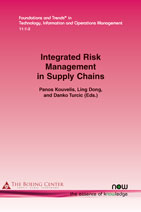Minimum-Variance Hedging for Managing Risks in Inventory Models with Price Fluctuations
By Caner Canyakmaz, Koç University, Turkey, ccanyakmaz@ku.edu.tr | Fikri Karaesmen, Koç University, Turkey, fkaraesmen@ku.edu.tr | Süleyman Özekici, Koç University, Turkey, sozekici@ku.edu.tr
Abstract
We consider the financial hedging of a random operational cash flow that arises in inventory operations with price and demand uncertainty. We use a variance minimization approach to find a financial portfolio that would minimize the total variance of operational and financial returns. For inventory models that involve continuous price fluctuations and price-dependent demand that arrives in continuous time, we characterize the minimum-variance hedging policies and numerically illustrate their effectiveness.
Integrated Risk Management in Supply Chains
Integrated Risk Management in Supply Chains examines supply chain risk management. The increased interest in the topic is due to a number of factors including the increased volatility of commodity prices and exchange rates, recent natural disasters, and the increased importance of multinational corporations. The motivation for risk management comes from a variety of sources: financial distress costs, managerial incentives, and other important reasons discussed in the remainder of this book. Understanding the motives is important because they provide insights into which risks should be managed and how a firm’s risk management operations should be organized.
The first part examines Buffering Supply Chain Risk with Operational Flexibility and deals with uncertainty in the form of routine variability, which includes fluctuations in demand. Part 2 reviews Supply Disruption. Both the preponderance of natural disasters and huge economic swings can cause extreme challenges across the supply chains. Although these types of risks are rare, they are highly consequential and buffering is insufficient to mitigate them. Instead, firms facing these risks must engage in contingency planning and must maintain redundancies in the system. This is why contingency planning is on the interface of operations and finance. Part 3 looks at Commodity Price Risks, which includes five papers on managing price risks – the first three papers are fundamental in that they ask “when” and “how” firms should manage price risks with hedging and how hedging affects operating policy and the remaining two papers examine the best practices in specific industries.

Companion
Foundations and Trends® in Technology, Information and Operations Management, Volume 11, Issue 1-2 Special Issue: Integrated Risk Management in Supply Chains
See the other articles that are also part of this special issue.